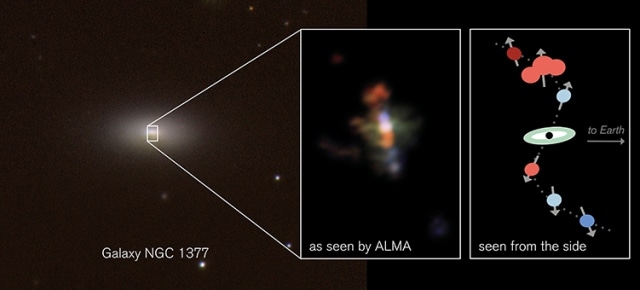Jul 5 2016
A Chalmers-led team of astronomers have used the Alma telescope to make the surprising discovery of a jet of cool, dense gas in the centre of a galaxy located 70 million light years from Earth.
 Alma’s close-up view of the centre of galaxy NGC 1377 (upper left) reveals a swirling jet. In this colour-coded image, reddish gas clouds are moving away from us, bluish clouds towards us, relative to the galaxy’s centre. The Alma image shows light with wavelength around one millimetre from molecules of carbon monoxide (CO). A cartoon view (lower right) shows how these clouds are moving, this time seen from the side. (Credit-CTIO/H. Roussel et al./ESO (left panel); Alma/ESO/NRAO/S. Aalto (top right panel); S. Aalto (lower right panel))
Alma’s close-up view of the centre of galaxy NGC 1377 (upper left) reveals a swirling jet. In this colour-coded image, reddish gas clouds are moving away from us, bluish clouds towards us, relative to the galaxy’s centre. The Alma image shows light with wavelength around one millimetre from molecules of carbon monoxide (CO). A cartoon view (lower right) shows how these clouds are moving, this time seen from the side. (Credit-CTIO/H. Roussel et al./ESO (left panel); Alma/ESO/NRAO/S. Aalto (top right panel); S. Aalto (lower right panel))
The jet, with its unusual, swirling structure, gives new clues to a long-standing astronomical mystery – how supermassive black holes grow.
A team of astronomers led by Susanne Aalto, professor of radio astronomy at Chalmers, has used the Alma telescope (Atacama Large Millimeter/submillimeter Array) to observe a remarkable structure in the centre of the galaxy NGC 1377, located 70 million light years from Earth in the constellation Eridanus (the River). The results are presented in a paper published in the June 2016 issue of the journal Astronomy and Astrophysics.
“We were curious about this galaxy because of its bright, dust-enshrouded centre. What we weren’t expecting was this: a long, narrow jet streaming out from the galaxy nucleus”, says Susanne Aalto.
The observations with Alma reveal a jet which is 500 light years long and less than 60 light years across, travelling at speeds of at least 800 000 kilometres per hour (500 000 miles per hour).
Most galaxies have a supermassive black hole in their centres; these black holes can have masses of between a few million to a billion solar masses. How they grew to be so massive is a long-standing mystery for scientists.
A black hole’s presence can be seen indirectly by telescopes when matter is falling into it – a process which astronomers call “accretion”. Jets of fast-moving material are typical signatures that a black hole is growing by accreting matter. The jet in NGC 1377 reveals the presence of a supermassive black hole. But it has even more to tell us, explains Francesco Costagliola (Chalmers), co-author on the paper.
“The jets we usually see emerging from galaxy nuclei are very narrow tubes of hot plasma. This jet is very different. Instead it’s extremely cool, and its light comes from dense gas composed of molecules”, he says.
The jet has ejected molecular gas equivalent to two million times the mass of the Sun over a period of only around half a million years - a very short time in the life of a galaxy. During this short and dramatic phase in the galaxy’s evolution, its central, supermassive black hole must have grown fast.
“Black holes that cause powerful narrow jets can grow slowly by accreting hot plasma. The black hole in NGC1377, on the other hand, is on a diet of cold gas and dust, and can therefore grow – at least for now – at a much faster rate”, explains team member Jay Gallagher (University of Wisconsin-Madison).
The motion of the gas in the jet also surprised the astronomers. The measurements with Alma are consistent with a jet that is precessing – swirling outwards like water from a garden sprinkler.
“The jet’s unusual swirling could be due to an uneven flow of gas towards the central black hole. Another possibility is that the galaxy’s centre contains two supermassive black holes in orbit around each other”, says Sebastien Muller, Chalmers, also a member of the team.
The discovery of the remarkable cool, swirling jet from the centre of this galaxy would have been impossible without Alma, concludes Susanne Aalto.
“Alma’s unique ability to detect and measure cold gas is revolutionising our understanding of galaxies and their central black holes. In NGC 1377 we’re witnessing a transient stage in a galaxy’s evolution which will help us understand the most rapid and important growth phases of supermassive black holes, and the life cycle of galaxies in the universe”, she says.